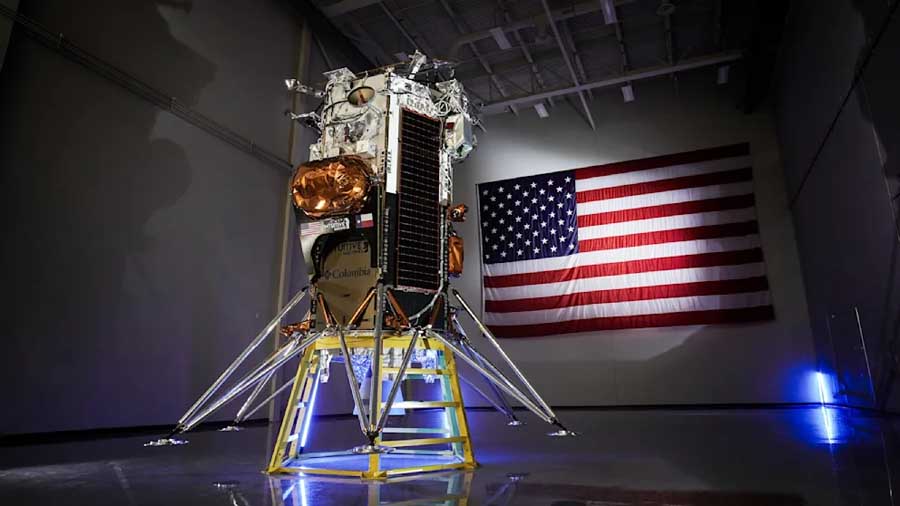 News Staff
News Staff![]() -
February 22, 2024 -
Technology
Moon
Steve Altemus
Bill Nelson
NASA's cheerleader-in-chief
SpaceX Falcon 9
-
1.6K views -
0 Comments -
1 Like -
0 Reviews
-
February 22, 2024 -
Technology
Moon
Steve Altemus
Bill Nelson
NASA's cheerleader-in-chief
SpaceX Falcon 9
-
1.6K views -
0 Comments -
1 Like -
0 Reviews

DLNews Technology:
With these words, Steve Altemus, the head honcho at Intuitive Machine, might as well have dropped the mic. At 12:39 a.m., in the dead of night when most of Earth was either dreaming or deep into a Netflix binge, the Nova-C probe entered the moon's dusty stage. The crowd (of scientists and engineers) went wild, but only after a suspenseful 15-minute wait, during which the only sound in the control room was the collective holding of breaths. The signal from Nova-C was as weak as the resolve to start a diet on a Monday until, finally, clarity! The Odysseus mission wasn't just successful; it was a homerun.

The lunar module over the near side of the moon, photo from February 21st.
Flashback to 1972, the last time Americans left their footprints on the lunar surface with Apollo 17. Fast forward to February 22, 2024, and here we are again, rewriting space history with a blend of pride, a dash of humor, and a significant leap in technology. Nearly 52 years later, the USA, in partnership with the private sector, has returned to our celestial neighbor, proving that age is just a number for space.

Looks unspectacular but is packed with the latest technology: Nova-C is scheduled to land on the moon today.
Bill Nelson, NASA's cheerleader-in-chief, couldn't contain his excitement. "Today, the USA returned to the moon for the first time in half a century. Today is when the power and possibilities of collaboration between NASA and the private sector become apparent.” Imagine the high-fives and the possibly awkward chest bumps in the control room.

A Falcon 9 rocket from Elon Musk's SpaceX company takes the lunar lander into space.
The Nova-C lunar lander, courtesy of Intuitive Machine and riding atop a SpaceX Falcon 9 like a surfer catching the perfect wave, was packed with NASA's scientific instruments. Its touchdown at 12:23 a.m. was smoother than a Sinatra song, a fully automated landing that had everyone on the edge of their seats for 16 nail-biting minutes until the "all clear" signal was sent.
Our lunar outpost, a cratered highland in the moon's south polar region, might as well have rolled out the welcome mat. This spot, visible from Earth with just the right pair of binoculars and a lot of imagination, is where Nova-C set its gears down. The goal? To lay the groundwork for the Artemis mission to bring humans back for a lunar encore in the next couple of years.

Nova-C touched down at the bottom of the moon's south polar region.
So, what's on the agenda for our robotic pioneer? For starters, it's playing weatherman and studying the interactions between space weather and the lunar surface. Then, there's the task of setting up a cosmic GPS network with retroreflectors because even on the moon, no one likes asking for directions. And let's remember about studying how the moon's surface reacts to being blasted by lander nozzles. It's all in a day's work for Nova-C, ensuring that when humans return, it's not just a tiny step but a giant leap... again.
As we stand (or sit, no judgment here) on Earth, gazing up at the night sky, let's take a moment to appreciate this monumental achievement. The USA has marked its return to the moon and set the stage for the next chapter in lunar exploration. With a mix of old glory and new technology, the message is clear: Welcome back to the moon, and we're here to stay this time. Cue the space-themed playlist, and let's get ready for the next giant leap!
At Desert Local News, connections are everything. We're not just another social networking platform—we're a lively hub where people from all walks of life come together to share stories, spark ideas, and grow together. Here, creativity flourishes, communities grow stronger, and conversations spark global awareness.